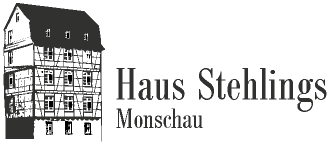At this point, around 1782, the cloth manufacturer Matthias Strunck built his residential and commercial building. Of all the members of the “rough garment”, he made the largest turnover. The cloth manufacturers of the “rough garments” processed the wool of the Eifel sheep and mainly produced cloth for the local market within the Duchy of Jülich.
The manufacturers of the “fine garments” such as Scheibler, Barkhausen or Troisdorf bought, in contrast to the “coarse garments”, high-quality Spanish merino wool and processed them into precious and fashionable cloths, which found great sales at the royal courts from England to Russia. As a result, their sales and earnings were much higher, which can be seen in their splendid houses.
In front of the house there was a woolen laundry on the Rur.
In the first half of the 19th century the house belonged to Johann Hubert Ubach or his widow. In the census of 1799, Hubert Ubach, 39 years old, his wife Anna Sybille née Mathie, 40 years old, and his 16-year-old niece Anna Cath. Sybertz were listed. In the first two decades of the 19th century, J.H. Ubach was one of the more important coarse cloth manufacturers.
In 1817 he lent the local fulling mill cooperative 600 thalers at an interest rate of 4% to buy a house and received a mortgage on the house and the two trade mills as security. He belonged to the Monschau city council in 1808 and 1817. Apparently the couple were childless. The widow appears in an address book as a cloth manufacturer in Monschau in 1830.
On February 25th, 1826 a fire broke out on the Stehling, which destroyed this and 2 other neighboring houses. The Rheinisch-Bergische Feuerversicherungs-Anstalt paid 2,431 thalers for the reconstruction in 1828/29. The neighboring house Stehling 10, which was also destroyed, was only rebuilt in 1925/26.
After the death of the widow Anna Sybille Ubach, according to the cadastral entry in 1851, the Julius Oeder bank in Aachen acquired the house, which it sold on in 1861 to the insurance agent Theodor Küpper, who lived here with his family.
The building has housed various public facilities since the 1850s. From 1857 the Monschau peace court was housed here for some time.
Between 1908 and 1919 the headquarters of the “Savings and Loans Fund of the Montjoie District” (later: Kreissparkasse) as well as the Monschau city treasury and the municipal treasuries of Höfen, Rohren and Kalterherberg were located here. In 1919, the savings bank of the Montjoie district” moved into the building that is now Café Kaulard on the market square.
After the Second World War, the savings bank´s director Ewald Förster bought the house, which is why the building is popularly known as the “House Förster”.
In 2008 the Walentovski family (now the owners of Café Hüftgold) bought the house and converted it into a hotel.
In 2018 the current owner, Johannes Zeller, took over the house and currently rents rooms and holiday apartments there (www.haus-stehlings.de).
